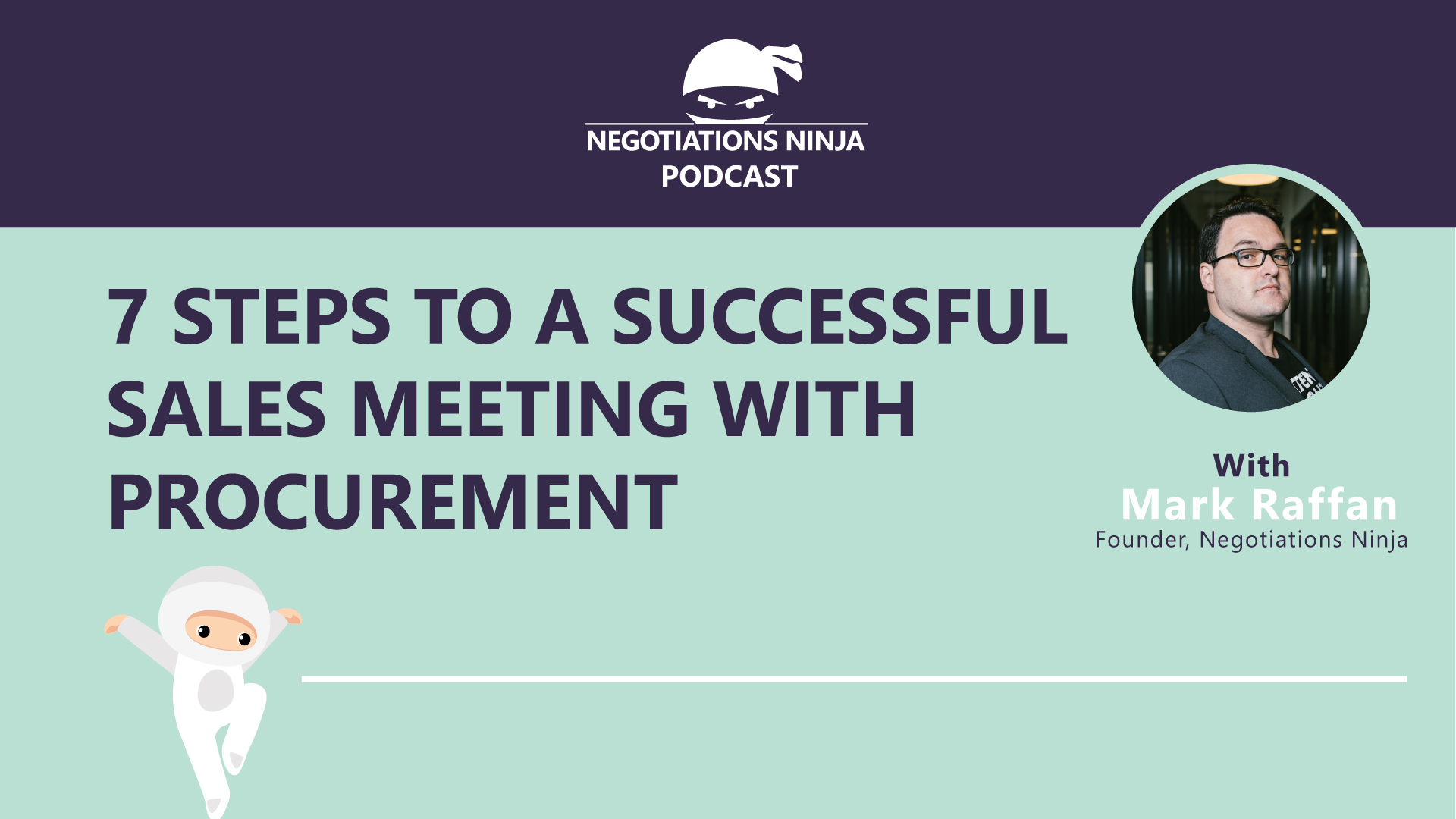This week’s solo podcast is for all my sales friends around the world. I get a lot of questions from sales professionals about how to have a successful sales meeting with procurement professionals. You’ve secured your first sales meeting with a procurement team—now what? What content should you cover? Who’s your audience? Are there more stakeholders outside the procurement team? What are the logistics around setting up the meeting? This episode of the Negotiations Ninja podcast delivers the ins and outs of successful sales meetings in seven steps.
Outline of This Episode
- [0:35] Salespeople: Successful Sales meetings
- [2:35] Step #1: Ask good questions
- [4:54] Step #2: Stand and implement good posture
- [6:26] Step #3: Dress appropriately for the industry
- [7:37] Step #4: Bring snacks to the table
- [8:42] Step #5: Practice, practice, practice
- [9:34] Step #6: Be prepared to be derailed
- [11:03] Step #7: Get your next meeting scheduled
How successful sales meetings begin
How do you have a successful meeting with a procurement team? What happens once you secure a sales meeting? The key—as with public speaking—is to remember your audience and speak to their needs and wants. You aren’t just selling to the business consumer, you’re selling to stakeholder groups within an organization. Financing, legal, procurement, operations—the list goes on. Each of those groups has their own needs and wants.
Speaking to your audience begins with asking good questions. In order to ask good questions, you must have prepared them in advance so they can be asked properly. Most importantly, keep questions open-ended – each question should start with a “what”, “why”, or “how.” For example, “What are the challenges you’re facing? How are those challenges affecting your business? Why do you suppose you’re experiencing those challenges?” Have at least five open-ended questions prepared that will generate conversation.
Then listen. Don’t get caught up in the next question or closing the sale. The information you miss by not listening is staggering. So take good notes so you remember what they’re going to say.
Make a good impression
Don’t just sit and talk about your service or product. It looks lazy. Implement good posture to show confidence. Procurement people see hundreds of sales presentations a year and most of them are terrible. It’s easy to stand out if you’re well-prepared and deliver. Make sure you’ve practiced and don’t read straight off of a slide deck. If you don’t know the answer to a question, don’t make it up. Say you’ll get back to them, and then get back to them.
I’ve seen a lot of salespeople not properly dressed for the occasion. If you’re presenting in a corporate office, dress like them. Wear a suit. If you’re in a manufacturing environment, wear jeans and a golf shirt. You need to connect to your audience and one of the best ways to do that is to dress like one of them. If you wear a three-piece suit to a manufacturer, people will be really confused. What’s another critical step that involves food? Listen to find out!
Practice—but be prepared…
Did you know you only have 7 seconds to create a really good first impression? You can easily ruin that if your presentation sucks. Practice your presentation before you come. If you’re not prepared—don’t bother coming. You’re wasting everyone’s time. You’ll look bad and create a bad first impression.
But you also have to be prepared to have your presentation derailed by procurement. Sometimes procurement people just do this for fun. They will ask complex questions. They’ll often ask questions you can’t answer. Sometimes, if the procurement person is having an awful day, they will try to trip you up and sink you. It sucks to hear this—but it happens. So prepare for this.
My last tip? Always suggest a next step. I’ve had many salespeople present to me and then just walk out. When you do that, you’re missing your critical opportunity to close the next step. The procurement person won’t ask for it. So I recommend that you prepare a few possible next steps to present. Suggest times to meet and lock it down. These all seem like simple steps, but sometimes the simplest things are the hardest to implement.
Connect With Mark
- Follow Negotiations Ninja on Twitter: @NegotiationPod
- Connect with Mark on LinkedIn
- Follow Negotiations Ninja on LinkedIn
- Connect on Instagram: @NegotiationPod




